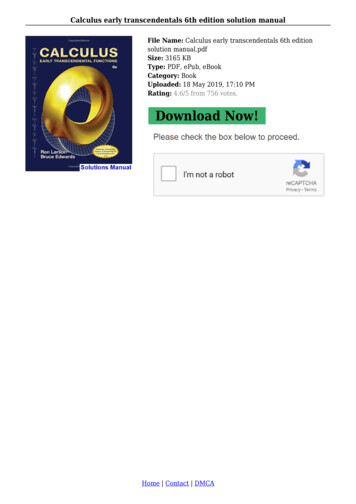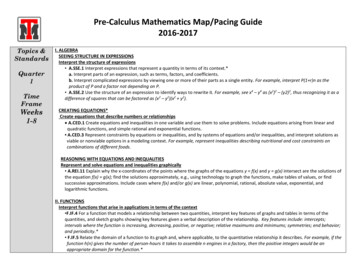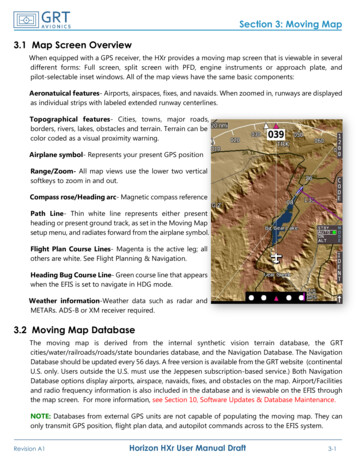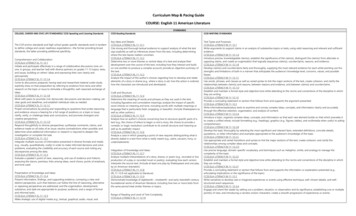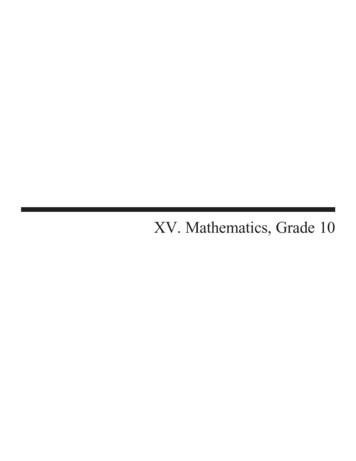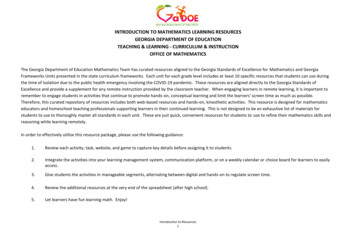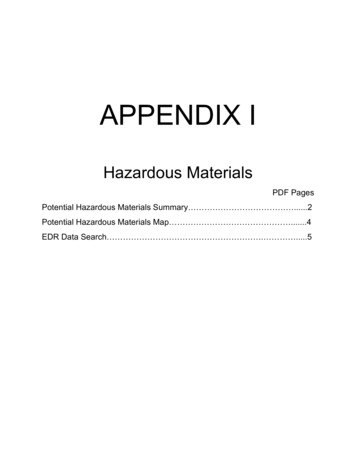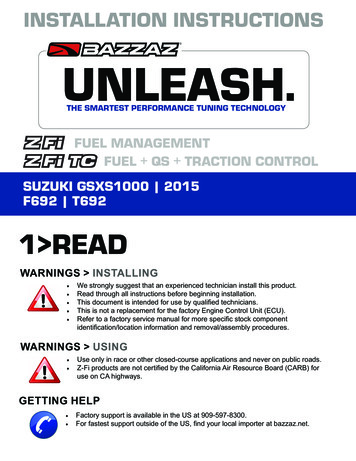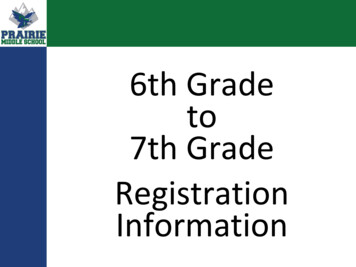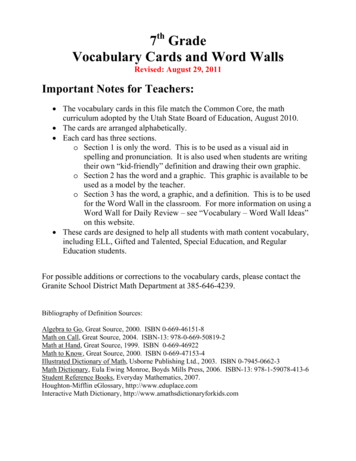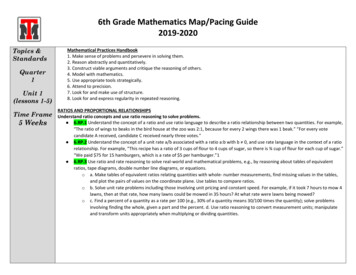
Transcription
6th Grade Mathematics Map/Pacing Guide2019-2020Topics &StandardsQuarter1Unit 1(lessons 1-5)Time Frame5 WeeksMathematical Practices Handbook1. Make sense of problems and persevere in solving them.2. Reason abstractly and quantitatively.3. Construct viable arguments and critique the reasoning of others.4. Model with mathematics.5. Use appropriate tools strategically.6. Attend to precision.7. Look for and make use of structure.8. Look for and express regularity in repeated reasoning.RATIOS AND PROPORTIONAL RELATIONSHIPSUnderstand ratio concepts and use ratio reasoning to solve problems. 6.RP.1 Understand the concept of a ratio and use ratio language to describe a ratio relationship between two quantities. For example,“The ratio of wings to beaks in the bird house at the zoo was 2:1, because for every 2 wings there was 1 beak.” “For every votecandidate A received, candidate C received nearly three votes.” 6.RP.2 Understand the concept of a unit rate a/b associated with a ratio a:b with b 0, and use rate language in the context of a ratiorelationship. For example, “This recipe has a ratio of 3 cups of flour to 4 cups of sugar, so there is ¾ cup of flour for each cup of sugar.”“We paid 75 for 15 hamburgers, which is a rate of 5 per hamburger.”1 6.RP.3 Use ratio and rate reasoning to solve real-world and mathematical problems, e.g., by reasoning about tables of equivalentratios, tape diagrams, double number line diagrams, or equations.o a. Make tables of equivalent ratios relating quantities with whole- number measurements, find missing values in the tables,and plot the pairs of values on the coordinate plane. Use tables to compare ratios.o b. Solve unit rate problems including those involving unit pricing and constant speed. For example, if it took 7 hours to mow 4lawns, then at that rate, how many lawns could be mowed in 35 hours? At what rate were lawns being mowed?o c. Find a percent of a quantity as a rate per 100 (e.g., 30% of a quantity means 30/100 times the quantity); solve problemsinvolving finding the whole, given a part and the percent. d. Use ratio reasoning to convert measurement units; manipulateand transform units appropriately when multiplying or dividing quantities.
6th Grade Mathematics Map/Pacing Guide2019-2020SPIRAL REVIEW Bell Work Standards covered during Bell Work will be based on prerequisites for the current concept as well as data from our weeklyIlluminate Assessments. iReady Students are assigned lessons based on their academic needs, not necessarily the current standards being taught. Studentshave a goal of obtaining at least 45 minutes/week on iReady and maintaining a 70% or higher passing rate. Students’ time oniReady is actively monitored to ensure they are working diligently and accurately.MAJOR SUPPORTING ADDITIONALStudents should spend the majority of learning on the major work of the grade level; which should account for at least 65% of the academic year (Achievethe core, n.d.). Major content should be emphasized via a greater number of days of instruction, depth and mastery.Assessment(Evidence)Key Concepts andSkillsFormative Assessment:Independent PracticeEnd of Lesson QuizzesHomework Checks Write a ratio to describethe relationship betweentwo quantities. Find the rate and unitrate associated with agiven ratio. Compare ratios and findequivalent ratios Solve unit rate problems Solve percent problemsLesson QuizzesLesson 1/Day 4Lesson 2/Day 5Lesson 3/Day 5Lesson 4/Day 5Lesson 5/Day 5Ready Ohio MathAssessment Resources i-Ready Diagnostic (fall,winter, spring) Unit Self-checkCurriculum & TextbookResourcesReady OhioKey Concept tools &practicesAvailable on Teacher Toolbox:Practice and Problem Solving Pages(Student) pg. 3-48 Interactive Tutorials Prerequisite Ready LessonsiReady Lessons (online)15 - 20 min per lesson Tools for Instruction Math Center Activities Think-Share-Compare Routine(under ProgramImplementation) Ready-Central (InstructionalBest Practices Videos http://readycentral.com/ Journals / Provisional WritingReady Teacher Resource Bookpg. 1a - 50bUnit Lessons Lesson 1: Ratios 6.RP.1 Lesson 2: Understand Unit Rate6.RP.2, 6.RP.1, 6.RP.3a, 6.RP.3b,6.RP.3d Lesson 3: Equivalent Ratios6.RP.3a
6th Grade Mathematics Map/Pacing Guide2019-2020Summative AssessmentUnit 1 Interim Assessment Topics &StandardsQuarter1Unit 2(lessons 6-8)Time Frame3 WeeksLesson 4 Solve Problems withUnit Rate 6.RP.3b, 6.RP.3dLesson 5: Solve Problems withPercent 6.RP.3c, 6.RP.3a, 6.RP.3b Math Models Discourse CardsThe Number SystemApply and extend previous understandings of multiplication and division to divide fractions by fractions. 6.NS.1 Interpret and compute quotients of fractions, and solve word problems involving division of fractions by fractions, e.g., byusing visual fraction models and equations to represent the problem. For example, create a story context for (2/3) (¾) and use avisual fraction model to show the quotient; use the relationship between multiplication and division to explain that (2/3) (¾) 8/9because ¾ of 8/9 is 2/3. (In general, (a/b) (c/d) ad/bc.) How much chocolate will each person get if 3 people share ½ lb ofchocolate equally? How many ¾-cup servings are in 2/3 of a cup of yogurt? How wide is a rectangular strip of land with length ¾ miand area ½ square mi?Compute fluently with multi-digit numbers and find common factors and multiples. 6.NS.2 Fluently divide multi-digit numbers using the standard algorithm.SPIRAL REVIEW Bell Work Standards covered during Bell Work will be based on prerequisites for the current concept as well as data from our weeklyIlluminate Assessments. iReady Students are assigned lessons based on their academic needs, not necessarily the current standards being taught. Studentshave a goal of obtaining at least 45 minutes/week on iReady and maintaining a 70% or higher passing rate. Students’ time oniReady is actively monitored to ensure they are working diligently and accurately.MAJOR SUPPORTING ADDITIONALStudents should spend the majority of learning on the major work of the grade level; which should account for at least 65% of the academic year (Achievethe core, n.d.). Major content should be emphasized via a greater number of days of instruction, depth and mastery.Assessment(Evidence)Formative Assessment:Independent PracticeEnd of Lesson QuizzesHomework ChecksKey Concepts andSkills Explain how to dividefractions, for example;233489explain why .Curriculum & TextbookResourcesReady OhioPractice and Problem Solving Pages(Student) pg. 59 - 86.Key Concept tools &practicesAvailable on Teacher Toolbox: Interactive Tutorials Prerequisite Ready Lessons
6th Grade Mathematics Map/Pacing Guide2019-2020Lesson QuizzesLesson 6/Day 4Lesson 7/Day 5Lesson 8/Day 5Ready Ohio MathAssessment Resources i-Ready Diagnostic (fall,winter, spring) Unit Self-checkSummative AssessmentUnit 1 Interim AssessmentTopic&StandardQuarter 2Unit 2Continued(lessons 9 - 14)Time Frame7 Weeks Divide multi-digit wholenumbers, for example;26,304 24 1,096.iReady Lessons (online)15 - 20 min per lessonReady Teacher Resource Book pg.51a - 70bUnit Lessons Lesson 6: Understand Divisionwith Fractions 6.NS.1 Lesson 7: Divide with Fractions6.NS.1 Lesson 8: Divide Multi-DigitNumbers 6.NS.2 Tools for Instruction Math Center Activities Think-Share-Compare Routine(under ProgramImplementation) Ready-Central (InstructionalBest Practices Videos http://readycentral.com/ Journals / Provisional Writing Math Models Discourse CardsThe Number SystemApply and extend previous understandings of multiplication and division to divide fractions by fractions. 6.NS.1 Interpret and compute quotients of fractions, and solve word problems involving division of fractions by fractions, e.g., by usingvisual fraction models and equations to represent the problem. For example, create a story context for (2/3) (¾) and use a visualfraction model to show the quotient; use the relationship between multiplication and division to explain that (2/3) (¾) 8/9 because¾ of 8/9 is 2/3. (In general, (a/b) (c/d) ad/bc.) How much chocolate will each person get if 3 people share ½ lb of chocolate equally?How many ¾-cup servings are in 2/3 of a cup of yogurt? How wide is a rectangular strip of land with length ¾ mi and area ½ square mi?Compute fluently with multi-digit numbers and find common factors and multiples. 6.NS.2 Fluently divide multi-digit numbers using the standard algorithm. 6.NS.3 Fluently add, subtract, multiply, and divide multi-digit decimals using the standard algorithm for each operation. 6.NS.4 Find the greatest common factor of two whole numbers less than or equal to 100 and the least common multiple of two whonumbers less than or equal to 12. Use the distributive property to express a sum of two whole numbers 1–100 with a common factor a multipleof a sum of two whole numbers with no common factor. For example, express 36 8 as 4 (9 2).Apply and extend previous understandings of numbers to the system of rational numbers. 6.NS.5 Understand that positive and negative numbers are used together to describe quantities having opposite directions or values(e.g., temperature above/below zero, elevation above/below sea level, credits/debits, positive/ negative electric charge); use positiveand negative numbers to represent quantities in real-world contexts, explaining the meaning of 0 in each situation. 6.NS.6 Understand a rational number as a point on the number line. Extend number line diagrams and coordinate axes familiar fromprevious grades to represent points on the line and in the plane with negative number coordinates.
6th Grade Mathematics Map/Pacing Guide2019-2020a) Recognize opposite signs of numbers as indicating locations on opposite sides of 0 on the number line; recognize that the oppositeof the opposite of a number is the number itself, e.g.,–(–3) 3, and that 0 is its own opposite.b) Understand signs of numbers in ordered pairs as indicating locations in quadrants of the coordinate plane; recognize that when twoordered pairs differ only by signs, the locations of the points are related by reflections across one or both axes.c) Find and position integers and other rational numbers on a horizontal or vertical number line diagram; find and position pairs ofintegers and other rational numbers on a coordinate plane. 6.NS.7 Understand ordering and absolute value of rational numbers.a) Interpret statements of inequality as statements about the relative position of two numbers on a number line diagram. For example,interpret –3 –7 as a statement that –3 is located to the right of –7 on a number line oriented from left to right.b) Write, interpret, and explain statements of order for rational numbers in real-world contexts. For example, write –3 C –7 C toexpress the fact that –3 C is warmer than –7 C.c) Understand the absolute value of a rational number as its distance from 0 on the number line; interpret absolute value as magnitudefor a positive or negative quantity in a real-world situation. For example, for an account balance of –30 dollars, write –30 30 todescribe the size of the debt in dollars.d) Distinguish comparisons of absolute value from statements about order. For example, recognize that an account balance less than–30 dollars represents a debt greater than 30 dollars. 6.NS.8. Solve real-world and mathematical problems by graphing points in all four quadrants of the coordinate plane. Include use ofcoordinates and absolute value to find distances between points.SPIRAL REVIEW Bell Work Standards covered during Bell Work will be based on prerequisites for the current concept as well as data from our weeklyIlluminate Assessments. iReady Students are assigned lessons based on their academic needs, not necessarily the current standards being taught. Studentshave a goal of obtaining at least 45 minutes/week on iReady and maintaining a 70% or higher passing rate. Students’ time oniReady is actively monitored to ensure they are working diligently and accurately.MAJOR SUPPORTING ADDITIONALStudents should spend the majority of learning on the major work of the grade level; which should account for at least 65% of the academic year (Achieve thecore, n.d.). Major content should be emphasized via a greater number of days of instruction, depth and mastery.Assessment(Evidence)Formative Assessment:Independent PracticeEnd of Lesson QuizzesHomework ChecksKey Concepts andSkills Divide multi-digit wholenumbers, for example 26,304 24 1,096.Curriculum & Textbook Key Concept tools &ResourcespracticesReady OhioPractice and Problem Solving Pages(Student) pg. 89-96Available on Teacher Toolbox: Interactive Tutorials Prerequisite Ready Lessons Tools for Instruction
6th Grade Mathematics Map/Pacing Guide2019-2020Topic &StandardQuarter 2Unit 3(lesson 15)Time Frame1 Week Add and subtract multi-digitiReady Lessons (online)Lesson Quizzesdecimals, for example 3.1 15 - 20 min per lesson1.534 1.566.Lesson 9/Day 4 Multiply and divide decimals, for Ready Teacher Resource Book pg.Lesson 10/Day 480a-139cexample 32.5 0.25 130Lesson 11/Day 4 Find common factors andLesson 12/Day 4Unit Lessonscommon multiples, for example: Lesson 9: Add & Subtract DecimalsLesson 13/Day 4common factors of 4 and 6 are 1 Lesson 10: Multiply & DivideLesson 14/Day 4and 2, and common multiples areDecimals12 and 24.Ready Ohio Math Lesson 11 Common Factors and Recognize real-world uses forAssessment ResourcesMultiples:negative numbers and locate i-Ready Diagnostic (fall, Lesson 12: Understand Positive &them on a number line.winter, spring)Negative Numbers order integers and find absolute Unit Self-check Lesson 13: Absolute Value andvalue, for example: 7 Ordering Numbers 5 𝑎𝑛𝑑 5 2.Summative Assessment Lesson 14: The Coordinate Plane Plot points in 4 quadrants of theUnit 2 Interim Assessmentcoordinate plane.EXPRESSIONS AND EQUATIONSApply and extend previous understandings of arithmetic to algebraic expressions. 6.EE.1 Write and evaluate numerical expressions involving whole-number exponents. Math Center ActivitiesThink-Share-CompareRoutine (under ProgramImplementation)Ready-Central(Instructional BestPractices Videoshttp://readycentral.com/Journals / ProvisionalWritingMath ModelsDiscourse CardsSPIRAL REVIEW Bell Work Standards covered during Bell Work will be based on prerequisites for the current concept as well as data from our weeklyIlluminate Assessments. iReady Students are assigned lessons based on their academic needs, not necessarily the current standards being taught. Studentshave a goal of obtaining at least 45 minutes/week on iReady and maintaining a 70% or higher passing rate. Students’ time oniReady is actively monitored to ensure they are working diligently and accurately.MAJOR SUPPORTING ADDITIONALStudents should spend the majority of learning on the major work of the grade level; which should account for at least 65% of the academic year (Achievethe core, n.d.). Major content should be emphasized via a greater number of days of instruction, depth and mastery.
6th Grade Mathematics Map/Pacing Guide2019-2020Assessment(Evidence)Formative Assessment:Independent PracticeEnd of Lesson QuizzesHomework ChecksKey Concepts andSkills Evaluate numericalexpressions that containexponents, for example,24 6 22Curriculum &Textbook ResourcesReady OhioPractice and Problem SolvingPages (Student) pg. 161-168Lesson QuizzesLesson 15/Day 4iReady Lessons (online)15 - 20 min per lessonReady Ohio MathAssessment Resources i-Ready Diagnostic (fall,winter, spring) Unit Self-checkReady Teacher Resource Book pg.144a-153cUnit LessonsLesson 15: Numerical Expressionswith ExponentsKey Concept tools &practicesAvailable on Teacher Toolbox: Interactive Tutorials Prerequisite Ready Lessons Tools for Instruction Math Center Activities Think-Share-Compare Routine(under Program Implementation) Ready-Central (Instructional BestPractices Videos http://readycentral.com/ Journals / Provisional Writing Math Models Discourse CardsSummative AssessmentUnit 3 Interim AssessmentTopic &StandardQuarter 3Unit 3(lessons 16-21)TimeFrame5 WeeksUNIT 3Equations and ExpressionsApply and extend previous understandings of arithmetic to algebraic expressions 6.EE.2 Write, read, and evaluate expressions in which letters stand for numbers.a) Write expressions that record operations with numbers and with letters standing for numbers. For example, express thecalculation “Subtract y from 5” as 5 – y.b) Identify parts of an expression using mathematical terms (sum, term, product, factor, quotient, coefficient); view one or moreparts of an expression as a single entity. For example, describe the expression 2 (8 7) as a product of two factors; view (8 7)as both a single entity and a sum of two terms.c) Evaluate expressions at specific values of their variables. Include expressions that arise from formulas used in real-worldproblems. Perform arithmetic operations, including those involving whole number exponents, using the algebraic order ofoperations when there are no parentheses to specify a particular order. For example, use the formulas V s³ and A 6s² tofind the volume and surface area of a cube with sides of length s 1/2.
6th Grade Mathematics Map/Pacing Guide2019-2020 6.EE.3 Apply the properties of operations to generate equivalent expressions. For example, apply the distributive property to theexpression 3 (2 x) to produce the equivalent expression 6 3x; apply the distributive property to the expression 24x 18y to producethe equivalent expression 6 (4x 3y); apply properties of operations to y y y to produce the equivalent expression 3y.6.EE.4 Identify when two expressions are equivalent (i.e., when the two expressions name the same number regardless of which valueis substituted into them). For example, the expressions y y y and 3y are equivalent because they name the same number regardlessof which number y stands for. Reason about and solve one-variable equations and inequalities.6.EE.5 Understand solving an equation or inequality as a process of answering a question: which values from a specified set, if any,make the equation or inequality true? Use substitution to determine whether a given number in a specified set makes an equation orinequality true.6.EE.6 Use variables to represent numbers and write expressions when solving a real-world or mathematical problem; understand thata variable can represent an unknown number, or, depending on the purpose at hand, any number in a specified set. 7. Solve real-worldand mathematical problems by writing and solving equations of the form x p q and px q for cases in which p, q and x are allnonnegative rational numbers.6.EE.8 Write an inequality of the form x c or x c to represent a constraint or condition in a real-world or mathematical problem.Recognize that inequalities of the form x c or x c have infinitely many solutions; represent solutions of such inequalities on numberline diagrams.Represent and analyze quantitative relationships between dependent and independent variables. 6.EE.9 Use variables to represent two quantities in a real-world problem that change in relationship to one another; write an equationto express one quantity, thought of as the dependent variable, in terms of the other quantity, thought of as the independent variable.Analyze the relationship between the dependent and independent variables using graphs and tables, and relate these to the equation.For example, in a problem involving motion at constant speed, list and graph ordered pairs of distances and times, and write theequation d 65t to represent the relationship between distance and timeSPIRAL REVIEW Bell Work Standards covered during Bell Work will be based on prerequisites for the current concept as well as data from our weeklyIlluminate Assessments. iReady Students are assigned lessons based on their academic needs, not necessarily the current standards being taught. Studentshave a goal of obtaining at least 45 minutes/week on iReady and maintaining a 70% or higher passing rate. Students’ time oniReady is actively monitored to ensure they are working diligently and accurately.
6th Grade Mathematics Map/Pacing Guide2019-2020Assessment(Evidence)Formative Assessment:Independent PracticeEnd of Lesson QuizzesHomework ChecksLesson QuizzesLesson 16/Day 5Lesson 17/Day 5Lesson 18/Day 3Lesson 19/Day 5Lesson 20/Day 3Lesson 21/Day 5Ready Ohio MathAssessment Resources i-Ready Diagnostic (fall,winter, spring) Unit Self-checkSummative AssessmentUnit 3 Interim AssessmentTopic &StandardQuarter 3Unit 4Key Concepts andSkills Interpret and evaluatealgebraic expressions, forexample: 2(8 7) meanstwice the sum of 8 and 7. Solve equations, forexample: if 3 1𝑘, 𝑡ℎ𝑒𝑛2𝑘 6.Curriculum & TextbookResourcesReady OhioPractice and Problem Solving Pages(Student) pg. 171-232iReady Lessons (online)15 - 20 min per lessonReady Teacher Resource Book pg. 154a215c Solve inequalities, forUnit 3 Lessonsexample: If 3𝑥 Lesson 16: Algebraic Expressions15, 𝑡ℎ𝑒𝑛 𝑥 5.(6.EE.2a, 6.EE.2b, 6.EE.2c, 6.EE.6) Use equations and Lesson 17: Equivalent Expressionsinequalities to solve word(6.EE.3, 6.EE.4, 6.EE.6)problems. Write equations to show the Lesson 18: Understand Solutions toEquations (6.EE.5, 6.EE.6)relationship betweendependent and independent Lesson 19: Solve Equations (6.EE.6,variables.6.EE.7, 6.EE.5) Lesson 20: Solving Inequalities (6.EE.5,6.EE.8, 6.NS.6, 6.EE.7) Lesson 21: Dependent andIndependent Variables (6.EE.9, 6.EE.6)Key Concept tools &practicesAvailable on Teacher Toolbox: Interactive Tutorials Prerequisite Ready Lessons Tools for Instruction Math Center Activities Think-Share-Compare Routine(under ProgramImplementation) Ready-Central (InstructionalBest Practices Videos http://readycentral.com/ Journals / Provisional Writing Math Models Discourse CardsGeometrySolve real-world and mathematical problems involving area, surface area, and volume 6.G.1 Through composition into rectangles or decomposition into triangles, find the area of right triangles, other triangles, specialquadrilaterals, and polygons; apply these techniques in the context of solving real-world and mathematical problems. 6.G.3 Draw polygons in the coordinate plane given coordinates for the vertices; use coordinates to find the length of a side joiningpoints with the same first coordinate or the same second coordinate. Apply these techniques in the context of solving real-world andmathematical problems. 6.G.4 Represent three-dimensional figures using nets made up of rectangles and triangles, and use the nets to find the surface area ofthese figures. Apply these techniques in the context of solving real-world and mathematical problems
6th Grade Mathematics Map/Pacing Guide2019-2020TimeFrame3 WeeksEquations and ExpressionsApply and extend previous understandings of arithmetic to algebraic expressions 6.EE.2 Write, read, and evaluate expressions in which letters stand for numbers.a) Evaluate expressions at specific values of their variables. Include expressions that arise from formulas used in real-worldproblems. Perform arithmetic operations, including those involving whole-number exponents, in the conventional order whenthere are no parentheses to specify a particular order (Order of Operations). For example, use the formulas V s3 and A 6 s2to find the volume and surface area of a cube with sides of length s ½. 6.EE.6 Use variables to represent numbers and write expressions when solving a real-world or mathematical problem; understand thata variable can represent an unknown number, or, depending on the purpose at hand, any number in a specified set. 7. Solve real-worldand mathematical problems by writing and solving equations of the form x p q and px q for cases in which p, q and x are allnonnegative rational numbers.SPIRAL REVIEW Bell Work Standards covered during Bell Work will be based on prerequisites for the current concept as well as data from our weeklyIlluminate Assessments. iReady Students are assigned lessons based on their academic needs, not necessarily the current standards being taught. Studentshave a goal of obtaining at least 45 minutes/week on iReady and maintaining a 70% or higher passing rate. Students’ time oniReady is actively monitored to ensure they are working diligently and accurately.MAJOR SUPPORTING ADDITIONALStudents should spend the majority of learning on the major work of the grade level; which should account for at least 65% of the academic year (Achieve thecore, n.d.). Major content should be emphasized via a greater number of days of instruction, depth and mastery.
6th Grade Mathematics Map/Pacing Guide2019-2020Assessment(Evidence)Formative Assessment:Independent PracticeLesson QuizzesLesson 22/Day 4Lesson 23/Day 5Lesson 24/Day 5Ready Ohio Math AssessmentResources i-Ready Diagnostic (fall,winter, spring) Unit Self-checkTopic &6StandardQuarter 4Unit 4(lesson 25)TimeFrame1 ½ WeeksKey Concepts and Curriculum & TextbookSkillsResources Find the area oftriangles,quadrilaterals, andother polygons. Solve problems withpolygons in thecoordinate plane. Use nets to find thesurface area of threedimensional figures.Ready OhioPractice and Problem Solving Pages(Student) pg. 247-276iReady Lessons (online)15 - 20 min per lessonReady Teacher Resource Book pg.220a-251cUnit 4 LessonsLesson 22: Area of PolygonsLesson 23: Polygons in theCoordinate PlaneLesson 24: Nets & Surface AreaKey Concept tools &practicesPacing Available on Teacher Toolbox: Interactive Tutorials Prerequisite Ready Lessons Tools for Instruction Math Center Activities Think-Share-Compare Routine(under Program Implementation) Ready-Central (Instructional BestPractices Videos http://readycentral.com/ Journals / Provisional Writing Math Models Discourse CardsGeometrySolve real-world and mathematical problems involving area, surface area, and volume 6.G.2. Find the volume of a right rectangular prism with fractional edge lengths by packing it with unit cubes of the appropriate unitfraction edge lengths, and show that the volume is the same as would be found by multiplying the edge lengths of the prism. Apply theformulas V l w h and V b h to find volumes of right rectangular prisms with fractional edge lengths in the context of solving realworld and mathematical problems.SPIRAL REVIEW Bell Work Standards covered during Bell Work will be based on prerequisites for the current concept as well as data from our weeklyIlluminate Assessments. iReady Students are assigned lessons based on their academic needs, not necessarily the current standards being taught. Studentshave a goal of obtaining at least 45 minutes/week on iReady and maintaining a 70% or higher passing rate. Students’ time oniReady is actively monitored to ensure they are working diligently and accurately.MAJOR SUPPORTING ADDITIONALStudents should spend the majority of learning on the major work of the grade level; which should account for at least 65% of the academic year (Achieve thecore, n.d.). Major content should be emphasized via a greater number of days of instruction, depth and mastery.
6th Grade Mathematics Map/Pacing Guide2019-2020Assessment(Evidence)Formative Assessment:Independent PracticeLesson QuizzesLesson 25/Day 4Ready Ohio MathAssessment Resources i-Ready Diagnostic (fall,winter, spring) Unit Self-checkSummative AssessmentUnit 4 Interim AssessmentTopic &StandardQuarter 4Unit 5(lessons 26-29)TimeFrame4 WeeksKey Concepts andSkills Find the volume of arectangular prism withfractional edge lengths, forexample: the volume of a cubewith edges ½ inch is ⅛ cubicinch.Curriculum &Textbook ResourcesReady OhioPractice and Problem SolvingPages (Student) pg. 279-286iReady Lessons (online)15 - 20 min per lessonReady Teacher Resource Book pg.252a-261cUnit 4 LessonLesson 25: VolumeKey Concept tools &practicesAvailable on Teacher Toolbox: Interactive Tutorials Prerequisite Ready Lessons Tools for Instruction Math Center Activities Think-Share-Compare Routine(under Program Implementation) Ready-Central (Instructional BestPractices Videos http://readycentral.com/ Journals / Provisional Writing Math Models Discourse CardsStatistics and ProbabilityDevelop understanding of statistical variability. 6.SP.1 Develop statistical reasoning by using the GAISE model:a. Formulate Questions: Recognize and formulate a statistical question as one that anticipates variability and can be answeredwith quantitative data. For example, “How old am I?” is not a statistical question, but “How old are the students in myschool?” is a statistical question because of the variability in students’ ages. (GAISE Model, step 1)b. Collect Data: Design and use a plan to collect appropriate data to answer a statistical question. (GAISE Model, step 2)c. Analyze Data: Select appropriate graphical methods and numerical measures to analyze data by displaying variability withina group, comparing individual to individual, and comparing individual to group. (GAISE Model, step 3)d. Interpret Results: Draw logical conclusions from the data based on the original question. (GAISE Model, step 4) 6.SP.2 Understand that a set of data collected to answer a statistical question has a distribution which can be described by its center,spread, and overall shape. 6.SP.3 Recognize that a measure of center for a numerical data set summarizes all of its values with a single number, while a measureof variation describes how its values vary with a single number. Summarize and describe distributions. 6.SP.4 Display numerical data in plots on a number line, including dot plots, line plots, histograms, & box plots. (GAISE Model, step 3) 6.SP.5 Summarize numerical data sets in relation to their contexto a. Report the number of observations.o b. Describe the nature of the attribute under investigation, including h
6th Grade Mathematics Map/Pacing Guide 2019-2020 Topics & Standards Quarter 1 Unit 1 (lessons 1-5) Time Frame 5 Weeks c Mathematical Practices Handbook 1. Make sense of problems and persevere in solving them. 2. Reason abstractly and quantitatively. 3. Construct viable arguments and critique the reasoning of others. 4. Model with mathematics. 5.

